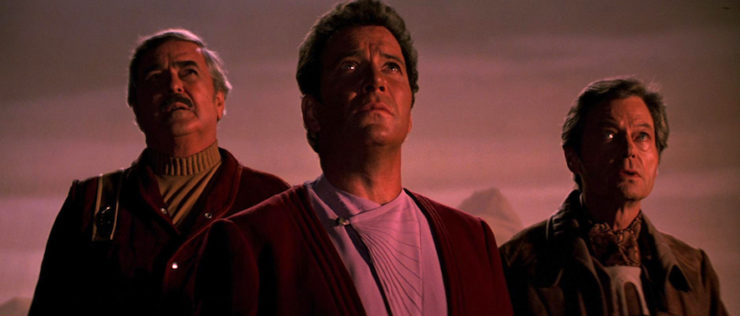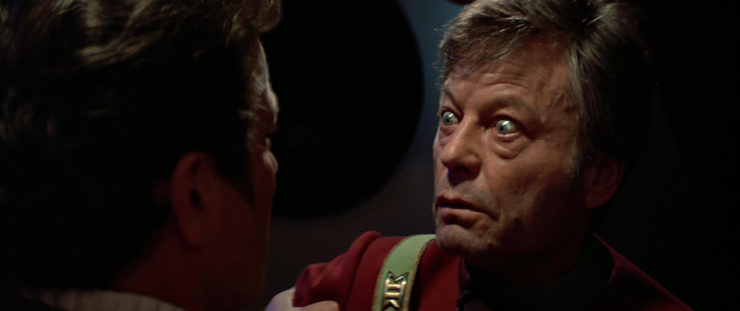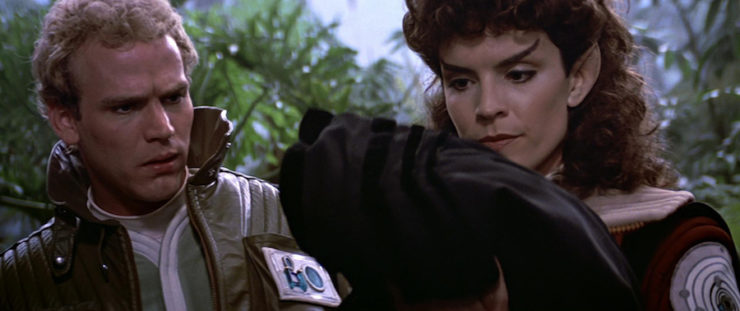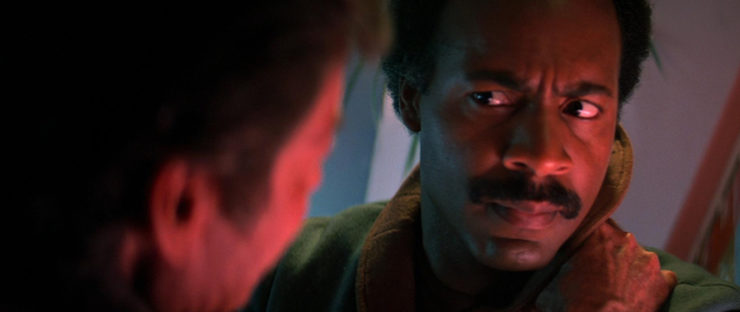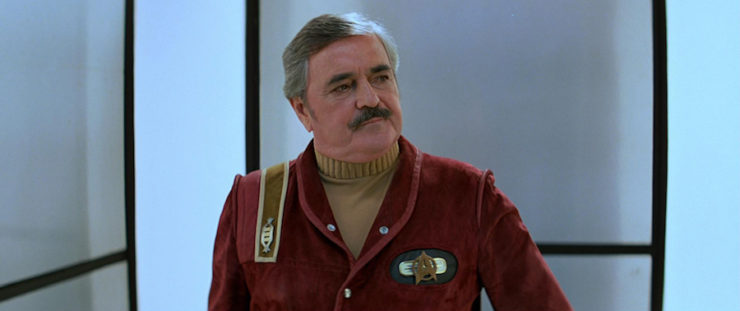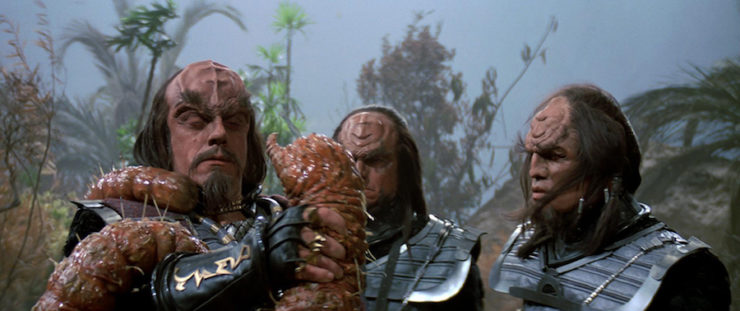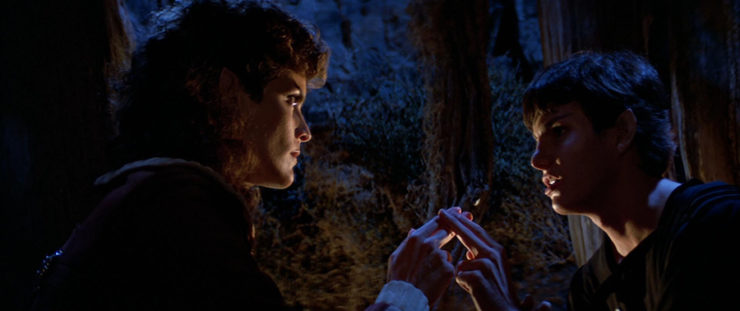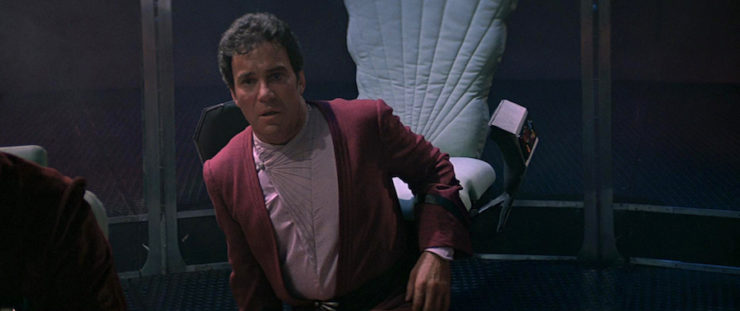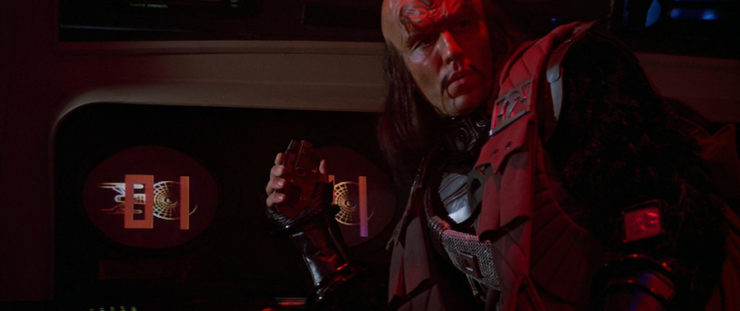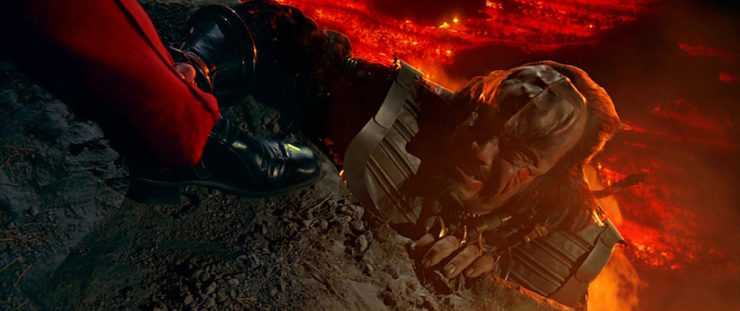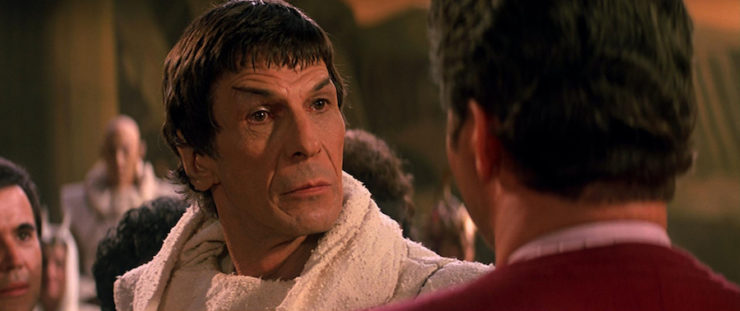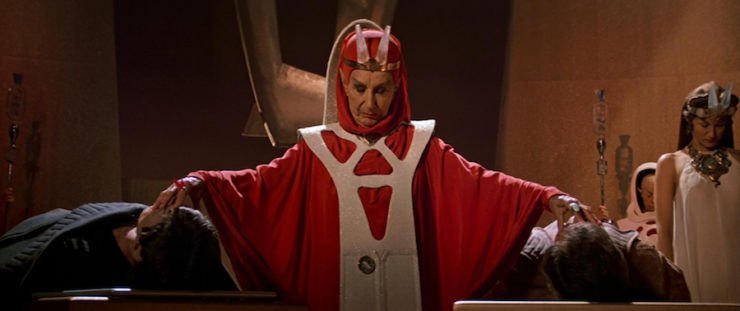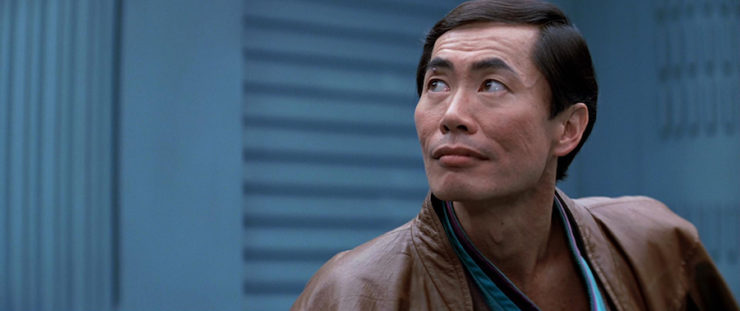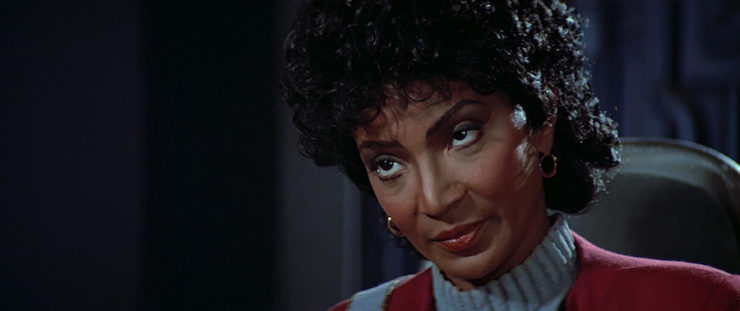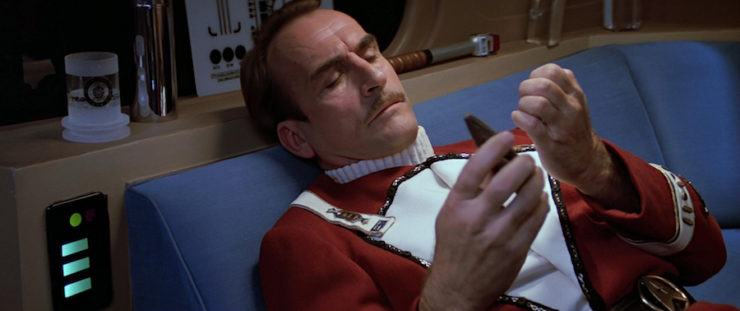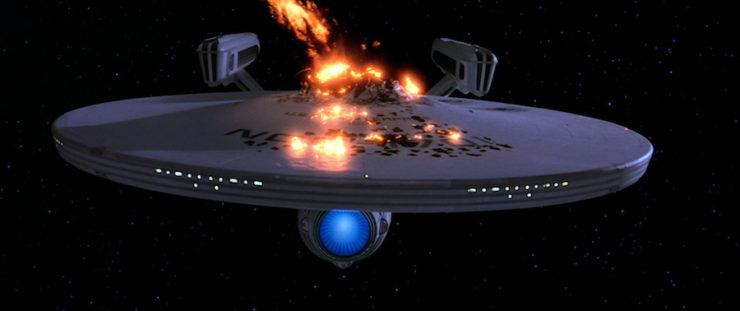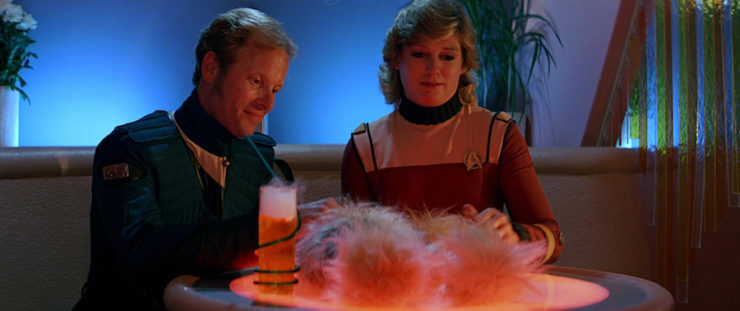Star Trek III: The Search for Spock
Written by Harve Bennett
Directed by Leonard Nimoy
Release date: June 1, 1984
Stardate: 8210.3
Captain’s log. We open by watching Spock’s death and funeral again from The Wrath of Khan, as well as Spock giving the “space, the final frontier” monologue before the credits, which run over the Genesis Planet and Spock’s torpedo on its surface.
The Enterprise is en route to Earth, its battle damage repaired, most of its cadet crew reassigned. The ship has a skeleton crew—including Chekov, who has to reluctantly take the science station at one point. Kirk is more than a little beside himself over Spock’s death.
Elsewhere, a Klingon woman named Valkris has purchased the Genesis data on the black market and delivers it to a Klingon captain named Kruge. He then kills her by destroying the vessel she hired for the rendezvous, as she has seen the data.
Enterprise arrives at Spacedock, passing by Excelsior, a.k.a. “the great experiment,” a transwarp drive vessel about to go out on its shakedown. As they dock, Chekov receives a security alert that someone has broken into Spock’s quarters. Kirk investigates to discover McCoy—but speaking in Spock’s voice, asking why Kirk left him on Genesis. He wants to go home to Mt. Seleya—which is on Vulcan. Then McCoy collapses.
Admiral Morrow arrives to inspect the crew, and he has several surprise announcements: Scotty has been reassigned to Excelsior while Enterprise is to be decommissioned. And Genesis has become a galactic controversy, and no one in the crew is allowed to discuss it.
Kruge and two of his crew, Maltz and Torg, watch the same presentation we saw in Wrath of Khan, but with Kirk narrating rather than Marcus, for some reason. Kruge views this as the key to absolute power. He diverts his ship to the Mutara sector, though it’s not clear if this is an official mission of the Klingon Empire or Kruge himself making a power grab—either way, though, he wants Genesis.
The U.S.S. Grissom has been assigned to investigate the Genesis planet. Saavik and David have been assigned to Captain J.T. Esteban’s ship, and they discover numerous climates within an hour’s walk—and also life form reading near Spock’s tube, which appears to have soft-landed. There isn’t supposed to be any life on the planet. Saavik and David urge Esteban to let them beam down to investigate.
On Earth, Sulu, Chekov, and Uhura gather in Kirk’s apartment to toast absent friends. Scotty is off on Excelsior and McCoy is home, having been diagnosed with exhaustion. Their gathering is interrupted by Sarek, who requests to speak to Kirk alone. After Sulu, Chekov, and Uhura leave, Sarek asks why Kirk didn’t do as Spock requested and take his body to Vulcan, along with his katra. Kirk is confused, but after Sarek and Kirk mind-meld, Sarek realizes that Spock’s katra isn’t there; Sarek assumed that, since Kirk was with him when he died, Spock would have mind-melded with him. Kirk points out that Kirk and Spock were physically separated, so he couldn’t have mind-melded—but there’s McCoy, who’s acting weird and Spocklike. Maybe Spock left his katra with the good doctor?
Kirk and Sarek go to the archives to look over the Enterprise security feeds, and they see Spock neck-pinching McCoy and briefly mind-melding with him and saying, “Remember.”
Sarek informs Kirk that the only way for McCoy and Spock to find peace is to bring McCoy and Spock’s body to Mt. Seleya on Vulcan.
On the Genesis planet, Saavik and David beam down to find clam-sized creatures that David identifies as evolved versions of the microbes that were on the tube when they shot it from Enterprise. Saavik wonders how they evolved so fast.
But they’ve got bigger problems: the tube is empty, save for Spock’s burial robe, which has been folded neatly. They also hear a scream just as an earthquake hits.
Kirk meets with Morrow, who refuses to let Kirk go to Genesis to retrieve Spock’s body to bring it to Vulcan. Leaving aside any other considerations, Genesis is quarantined to everyone save for the Grissom. Kirk pretends to acquiesce, then informs Sulu and Chekov that he’s going anyhow.
McCoy goes to a bar to meet with a courier who can get him a ship—but the courier balks at the destination, as Genesis is forbidden. After the deal falls through, McCoy is arrested by Starfleet security. (Twice McCoy channels Spock, once to chastise the server for suggesting he order poison, once to try to neck-pinch the security guard. The latter is not at all successful.)
Kirk and Sulu break McCoy out of prison, with Kirk revealing to McCoy what’s going on (“That green-blooded son of a bitch—it’s his revenge for all the arguments he lost!”) and Sulu taking out the guards and their console. Scotty sabotages Excelsior from his position as their new captain of engineering, after which point Chekov beams him onto the Enterprise. Uhura got herself assigned to a backwater transporter station, and beams Kirk, Sulu, and McCoy to the Enterprise also (she’s forced to lock the junior officer assisting her in the closet). Scotty reports that everything’s automated and that a chimpanzee and two trainees could run her. Kirk dryly says he’ll try not to take that personally.
Kirk gives the others a chance to back out—he and McCoy need to do this, the others don’t—but they take their stations. Scotty manages to hack into the doors to get them open, Sulu backs them out, and Excelsior‘s attempt to pursue is stymied by Scotty’s sabotage.
David and Saavik proceed to a wintry portion of the Genesis planet, following traces of the second life form reading. They hear someone crying in pain, and they find a Vulcanoid boy shivering in the cold. Saavik informs Grissom, but their attempt to contact Starfleet is being jammed by Kruge, who decloaks and fires on the Grissom. The ship is destroyed, to Kruge’s annoyance—he wanted prisoners, and kills the gunner for his screwup—but Torg reports three lifesigns on the planet.
Kruge beams down with two of his subordinates. They come upon Spock’s tube, and now the “microbes” have become huge snakelike creatures. Meanwhile, Saavik confronts David over all the things that have gone wrong on Genesis, and David admits to using protomatter in the matrix. Protomatter is unstable (and also illegal and unethical to use) and is causing all the tectonic instability and the super-fast evolution.
They take refuge in a cave. Saavik is concerned about Spock’s rapid aging, in particular that he will experience pon farr. Sure enough, he starts to experience it, and so Saavik walks him through it, which probably isn’t weird and creepy.
Right after that, Kruge captures David, Saavik, and Spock. Saavik tries to convince him that Genesis is a failure, but it’s still sufficiently destructive that Kruge wants a piece of it.
Enterprise enters the sector, and Torg orders the Klingon ship to cloak and then informs Kruge, who beams back up. He gets close and then decloaks and fires, but Kirk sees distortion and is prepared for the possibility of a cloaked ship. Unfortunately, Scotty hadn’t expected there to be combat, so he can’t get shields up, and Kruge’s shot pretty much trashes the Enterprise right back.
Kirk tries to bluff Kruge, saying he’s giving him a chance to surrender, but Kruge thinks (rightly) that the Enterprise is in bad shape. He claims that the treaty violation he’s performed is as nothing compared to what the Federation has done by creating Genesis. He also threatens to kill his three prisoners.
Kruge lets Kirk talk to the prisoners, and Saavik is able to subtly reveal that Spock is alive, albeit “not himself.” David also tells him that Genesis doesn’t work. Kruge then proves that he is a man of his word by killing a prisoner—the Klingon on the surface is about to kill Saavik, but David jumps him and is killed in her stead. Kirk is beside himself, and Kruge makes it clear that the other two will be next if he doesn’t surrender.
Kirk asks for time to inform his crew, which Kruge grants. He orders Torg to form a boarding party with the remaining crew, leaving only Kruge and Maltz on board. Kirk, Scotty, and Chekov arm the destruct sequence. Torg and his party beam aboard even as Kirk and his people beam to the planet. Kruge realizes too late what is happening, and the boarding party is destroyed along with the Enterprise.
Sulu detects life form readings, and also says that the planet is unstable. On cue, another earthquake hits. Kirk and the landing party find the two Klingons, Saavik, and Spock. One Klingon has been knocked unconscious by a raging Spock, who is growing more ill as the planet tears itself apart, and Kirk shoots the other one.
McCoy’s examination confirms Spock’s rapid aging, and also that his mind is a void. “It seems, Admiral, that I have all his marbles.” Saavik says that removing him from the planet is the only thing that will save him—and the planet’s instability means that it’s the only thing that’ll save the rest of them, too—so Kirk contacts Kruge and taunts him. He tries to get the Klingon to beam them all up as the only way he’ll get Genesis, but Kruge instead beams down. He has Maltz beam Sulu, McCoy, Scotty, Chekov, and Saavik to his ship. Kruge won’t beam Spock back because it’s what Kirk wants.
Kirk and Kruge engage in fisticuffs. At one point, Kruge almost falls down a cliff. Kirk tries to save him, but Kruge tries to drag Kirk down with him. Kirk kicks him in the head three times, and Kruge falls to his doom. Kirk grabs Spock and impersonates Kruge on the Klingon communicator to get Maltz to beam him up.
Maltz is surprised to see Kirk, and he’s stunned enough that Saavik is able to grab his weapon. Chekov takes him prisoner while Sulu and Scotty manage to dope out the controls enough to fly them to Vulcan.
In the medical bay, McCoy tries to get Spock to talk, but he’s still tabula rasa—though he’s now fully aged to where he was when he died (which means he’s played by Leonard Nimoy now).
The Klingon vessel arrives on Vulcan, and lands near Mt. Seleya, where they are greeted by Sarek, Uhura, High Priestess T’Lar, and a whole mess of Vulcans. Because Spock’s body was restored by Genesis, Sarek is requesting an ancient ritual known as fal tor pan, to put Spock’s katra back in Spock’s body. T’Lar asks McCoy’s approval, which he gives despite the danger, and while grumbling, “Helluva time to ask.”
T’Lar performs the ritual, and it is, of course, successful. Spock is brought forward, and he recognizes Kirk and calls him, “Jim.” He also asks why Kirk did what he did, and he says, “The needs of the one outweighed the needs of the many.”
…and the adventure continues.
Can’t we just reverse the polarity? Apparently, David used protomatter in the Genesis matrix, which makes it unstable. According to Saavik, no reputable scientist would ever use it. How he blew this past his mother and all the other scientists, not to mention the people who approved their Federation funding after Marcus made her presentation, is left as an exercise for the viewer.
Fascinating. Vulcan tradition holds that when one is close to death, one mind-melds with someone close and deposits one’s thoughts and memories—the katra—so that it may be downloaded to the Hall of Ancient Thought on Mt. Seleya. That’s what Spock did to McCoy when he said “Remember” in the previous movie, but Genesis resurrecting his body enabled him to be reborn with the re-infusion ritual of fal tor pan.
I’m a doctor not an escalator. McCoy spends most of the movie with bits of Spock in his brain, causing him to speak in his voice on two different occasions and also use the science station. However, he’s unable to swing a neck pinch. McCoy also, as is his wont, gets most of the best lines.
Ahead warp one, aye. Sulu gets a great bit when they’re breaking McCoy out of prison. The very tall guard refers to him as “Tiny,” and when Kirk escapes with McCoy, Sulu throws the guard against a wall and then flips him, calmly declaring to his unconscious form, “Don’t call me ‘Tiny’.”
Hailing frequencies open. Uhura gets her own great scene, as she puts her transporter assistant in the closet. It’s not explained why she doesn’t then go along with the gang—instead, she just shows up on Vulcan when they arrive. (The novelization fixes this, having Uhura stay behind to jam communications to limit Starfleet’s ability to respond to the theft of the Enterprise. She then takes asylum in the Vulcan embassy.)
I cannot change the laws of physics! Scotty is made captain of engineering for Excelsior. Instead, he sabotages it and gets the Enterprise working well enough for a crew of half-dozen—not so much a skeleton crew as half a skull crew—to get it to the Mutara sector.
He also admits to Kirk that he pads his repair estimates by a factor of four to keep his rep as a miracle worker, which would become Scotty’s watchword going forward.
It’s a Russian invention. At the start of the film, Chekov is acting like he’s been the security chief of the Enterprise all along, not the first officer of another ship that was destroyed.
Go put on a red shirt. Kruge’s gunner destroys the Grissom with one shot. Kruge wanted prisoners, so he punishes the gunner by killing him. There are only about a dozen people on board, so this strikes me as not the best use of resources, but whatever.
No sex, please, we’re Starfleet. While David being Kirk’s son is front-and-center throughout, the existence of Carol Marcus is acknowledged only in a brief mention in the Genesis presentation, inexplicably now done by Kirk.
Channel open. “Gentlemen, your work here today has been outstanding. I intend to recommend you all for promotion—in whatever fleet we end up serving.”
Kirk to the crew after they depart Spacedock.
Welcome aboard. Robin Curtis replaces Kirstie Alley as Saavik, as the studio and Alley couldn’t come to terms on her return. Curtis plays the role as a straight, emotion-repressing Vulcan, showing none of the cracks Alley’s version did. Curtis will be back (briefly) in The Voyage Home, and also appear in the TNG two-parter “Gambit” in a different role.
Mark Lenard and Merritt Butrick return as Sarek and David, respectively, the former last seen in “Journey to Babel” and “Yesteryear.” Butrick will return in TNG as well, in the episode “Symbiosis,” while Lenard’s next appearance as Sarek will be in the very next movie.
Three actors best known at the time for their TV roles appear: Christopher Lloyd (Reverend Jim on Taxi) as Kruge, John Larroquette (Dan Fielding on Night Court) as Maltz, and James B. Sikking (Lt. Howard Hunter on Hill Street Blues) as Styles.
This movie has a kind of Robert Knepper moment, in that the late Miguel Ferrer was in this movie as the Excelsior first officer. I didn’t forget he was in it, but seeing him is sad, given his recent death. In addition, Phil Morris makes his second Trek appearance as a cadet, having played one of the kids in “Miri.” He’ll return thrice, twice on DS9 and once on Voyager.
Robert Hooks plays Morrow, Philip Richard Allen plays Esteban, and the great Dame Judith Anderson plays T’Lar.
Five different actors play Spock: Carl Steven, Vadia Potenza, Stephen Manley, Joe W. Davis, and finally Leonard Nimoy. At this point, six different people have played Spock, counting Billy Simpson voicing young Spock in “Yesteryear.”
Finally, we have the usual suspects of James Doohan, Walter Koenig, George Takei, and Nichelle Nichols. In addition, Grace Lee Whitney makes a cameo observing the Enterprise coming home.
Trivial matters: This movie is, obviously, a direct sequel to The Wrath of Khan, with the movie greenlit shortly after the previous movie came out. Harve Bennett’s initial outline was completed in September of 1982. Leonard Nimoy famously said he was looking forward to doing the next film after Wrath wrapped, which surprised everyone, since he only agreed to do the movie if his character was killed. Resurrecting Spock was part of every treatment Bennett did. The original outline also had Romulans rather than Klingons as the bad guys, and also featured a conflict with the Vulcans over Genesis.
This is the last appearance of this version of the Enterprise. It’s the first time the Enterprise is seen to be destroyed, though it’ll happen again with the Enterprise-D in Star Trek Generations and the Bad Robot timeline version in Star Trek Beyond.
Vonda N. McIntyre novelized this film as well, and her novel expanded a great deal of the story, in particular adding a lengthy prologue that included Carol Marcus recovering and identifying the bodies of the Genesis Project personnel whom Khan killed, a wake for Spock, a relationship between Saavik and David, Scotty burying Peter Preston, and also following up on Sulu being given command of the Excelsior, which she had included as part of the Wrath of Khan novelization. (He has the command taken, and given to Styles, because of his involvement with the now-classified Genesis.) She also gives a more scientifically plausible explanation for Genesis’s failure than the made-up protomatter (which David would never have been able to sneak past his mother and the entire Genesis team in any case). One character also comments that this is the second time that Admiral Kirk has taken the Enterprise on a mission, supplanting her captain, and both times that captain died (Decker in The Motion Picutre, Spock in Wrath of Khan).
The self-destruct sequence for the Enterprise is the same as that seen in “Let That Be Your Last Battlefield,” although it’s actually completed this time.
Because DC had the license for a monthly comic, and because they’d been telling current adventures, the comic book picked up the storyline after this movie, with Spock getting his memories fully restored thanks to mind-meld with his Mirror Universe counterpart. In the end, Kirk is given command of the Excelsior, with Sulu as his first officer and Saavik as his science officer, as well as McCoy, Scotty, Uhura, and Chekov in their usual spots. Spock was given command of his own ship, the Surak. When it was time to set up for The Voyage Home two years later, Kirk’s senior crew went renegade to save Spock, whose crew was killed by a virus that destroyed memory.
This is the third appearance of the tribbles, several of which are in the bar McCoy visits, following “The Trouble with Tribbles” and “More Tribbles, More Troubles.” They’ll next be seen in DS9‘s “Trials and Tribble-ations.”
T’Lar is seen again in the novelization of The Final Frontier, and also appears in the novels Vulcan’s Forge and Vulcan’s Heart by Josepha Sherman & Susan Shwartz.
Marc Okrand developed the Klingon language for this film, and the lexicon he created for this movie was put into book form in The Klingon Dictionary, which has been revised and expanded and adapted into many forms in the three decades since. It is also the basis of most of the Klingon language used on screen since. The movie also makes use of the Vulcan language he created for the previous film.
Along with the elderly Carol Marcus, the elderly Maltz plays a big role in the Genesis Wave novel series by John Vornholt, where the Genesis effect is re-created in the 24th century.
Kruge appears as a younger officer in the Klingon military in the short story “Though Hell Should Bar the Way” by Greg Cox in Enterprise Logs and in the My Brothers Keeper trilogy and the novel Faces of Fire, both by Michael Jan Friedman. An alternate timeline version of Kruge is in The Chimes at Midnight by Geoff Trowbridge in Myriad Universe: Echoes and Refractions.
This is the first time since “The Cage” that Nimoy’s billing is only in the closing credits. It will only happen again in Star Trek Into Darkness.
The Klingon unit of measurement kellicam is used for the first time in this movie. It will remain a standard Klingon unit of distance henceforth. We also see our first d’k tahg, a Klingon dagger, which will also be used as a personal dagger for Klingon warriors henceforth.
Leonard Nimoy makes his feature film debut as a director with this film, having previously directed a bunch of TV episodes and movies. He would spend the next decade or so directing movies before retiring from directing after lensing the pilot for the science fiction TV series Deadly Games in 1995.
To boldly go. “To absent friends.” I have an odd relationship with this movie. I consider Vonda McIntyre’s novelization of the film to be brilliant, one of the best Trek novels ever written. I actually read the novel before I saw the film—it was common up until about a decade ago or so for novelizations to be released a few weeks ahead of the film’s release to help build interest and also cash in on the anticipation—and I loved so many things about it.
It was, therefore, very disappointing to find that most of my favorite scenes in the novel weren’t in the film—or were radically different. I was so looking forward to seeing Scotty taking Preston home to his family to be buried, to watching Uhura use her communications skills to help the Enterprise escape Spacedock, the identification of the bodies of the Genesis team, Spock’s awkward and unpleasant wake, the Saavik-David romance, and so much more that wasn’t there.
Mind you, this movie was released the year I turned fifteen. I didn’t know about actor availability or about budgets or about other things—or about the fact that novelizers have to add material in order to make the page count. A movie only has a short story’s worth of actual story in it, so when you make a novel (as I’ve done a few times myself) you’ve got to put in extra stuff. I also know that McIntyre wrote the novel likely expecting Saavik to again be played by Kirstie Alley and played the same way. Even if she was aware of the recasting with Robin Curtis, she had no way of knowing that Curtis would play the role completely differently.
Still, that disappointment lingered for years. So did one other aspect that, unfortunately, still sticks in my craw today. Kirk’s response to David’s death and the destruction of the Enterprise and his fisticuffs with Kruge were all, in McIntyre’s prose, wrenching and emotional and gripping. But Shatner’s performances of those three scenes are dreadful. His “You Klingon bastard, you killed my son” recitation sounds like a high-school student trying to sound emotional, his “My God, Bones, what have I done” is flat and lifeless. Heck, I would’ve settled for him Shatnering the heck out of the latter line, but instead he goes too far in the other direction, underplaying it, and it doesn’t work. Then, after a really poorly choreographed fight with Kruge, we get the Shatneriest Shatnering of them all with “I (kick) have had enough (kick) of you (kick and fall off cliff).”
Watching it again now, I find the movie to be an odd mix of delightful and horrible. Parts of the movie are fantastic. I can watch the McCoy in the bar scene, the McCoy gets broken out of jail scene, the Sarek-Kirk discussion about Spock (though that, too, was better realized in the novelization, elevated in the movie by the performance of Mark Lenard), Kirk and Scotty’s miracle-worker conversation, Uhura putting “Mr. Adventure” in the closet, and the discussion among the Klingons of the Genesis device all the live-long day. Just in general, this movie is a great vehicle for DeForest Kelley, who is at his best here, McCoy’s suffering combined with his curmudgeonliness to make for a superlative and hilarious performance.
On the one hand, we see the loyalty this group of people have for each other. They’re willing to risk their careers to save Spock. Which is awesome, and also has the unintended side effect of at least saving one member of the Grissom crew as well. On the other hand, you gotta wonder why this was necessary. Sarek is a high-ranking Vulcan ambassador, with enough juice that he can get to look at the now-very-classified Genesis presentation. So why can’t he make a demand of the Federation Council that they allow Kirk to retrieve his son’s body? Instead, we just get Kirk asking Morrow and the latter making a dismissive, and borderline racist comment about how he never understood “Vulcan mysticism,” never mind that it all involves telepathy which is a well established part of Vulcan physiognomy and culture. Yes, Genesis is a hot potato politically, but Sarek should have more political clout than Kirk, so he should be the one to be making this happen. And Morrow needs to have a better reason than “Vulcans are weird.”
Plus, as I’ve stated elsewhere, this is the movie that pretty much singlehandedly created the notion that Jim Kirk is a rules-breaking maverick who goes his own way and does what he has to do, orders be damned. Which is completely, totally, thoroughly wrong, both in the context of Kirk in general and in the context of this movie. The only time in the original series that Kirk truly disobeyed orders was in “Amok Time,” and he’s doing it again here, and both times it was for the same reason, the only reason he would even consider such a thing: Spock’s life is at stake.
Yet, thanks to this damn movie, which contrives an excuse to heist the Enterprise (and then destroy it), the book on Kirk has been that he’s a devil-may-care renegade who thumbs his nose at authority, which both flies in the face of the evidence and contravenes the point of this movie, which is that he was willing to go to an extreme in this particular case. For it to be his default position henceforth misses the point that it was an extreme.
Also the heist itself is, shall we say, less than convincing. That’s another case where I still prefer the novelization, since McIntyre addressed that problem by having Uhura stay behind to work her magic. As it is, there’s no reason, none, given as to why Uhura doesn’t go along, except maybe I guess ’cause she’s a girl and girls don’t get to go on adventures. Sheesh. But at least that explains how it’s even possible that, in the heart of the Federation, at Starfleet frikkin Headquarters, there’s only one experimental ship available to chase them down.
The movie also suffers from a poor antagonist. I am abject in my love for Christopher Lloyd, but while he has his moments, he doesn’t quite cohere as a strong Klingon in this one. The bit where he, Maltz, and Torg discuss Genesis and its implications works well, as do a few other bits, but mostly he’s just shouting a lot and brings none of the nuance that John Colicos and Michael Ansara—and later David Warner and J.G. Hertzler and Michael Dorn, etc.—would bring to their Klingons. I find myself wishing for a casting switch, as John Larroquette does much more with much less as Maltz than Lloyd manages.
Having Genesis be a failure makes sense from a universe perspective, as that’s the only way to put that particular toothpaste back in the tube, but man does it not make sense. Somehow David snuck a horribly illegal and unethical thing into Genesis that none of the huge team of scientists (remember, the ones we saw in the previous film were just a skeleton crew; David specifically said that most of the team was on leave when Khan struck) noticed. Sure, I buy that.
Then again, the movie acts as if David was the only person who worked on Genesis. I can understand (if not actually approve) of the rest of the team being wished into the proverbial cornfield, but what about Carol Marcus? Her existence is not even truly acknowledged past one line of dialogue in one of the items that contributes to the removal of her from the story, to wit, having Kirk be the one to narrate the Genesis presentation rather than her (which, by the way, makes nothing like sense). Combined with marginalizing Uhura’s role in the whole thing, it casts an appalling sexist pall on the entire endeavor.
The recasting of Saavik is a disaster, with Curtis making the mistake that is common to far too many actors who play Vulcans: mistaking suppressing your emotions for having none. Her Saavik is flat and boring and completely uninteresting. The movie grinds to a halt every time she’s on camera, which is particularly bizarre when they try to write a half-creepy sex scene with her and teenage Spock, which just fails on every level. They would’ve been better off not even acknowledging pon farr. (It doesn’t help that Saavik mentions it as if it were common knowledge, even though it was sufficiently verboten to discuss that Spock has to be practically put in a headlock to talk about it in “Amok Time.”) One wonders if this, as well as Shatner’s poor performance, can be attributed to a director who’d never been in charge of a feature film before…
Honestly, though, the worst sin this movie commits is to negate two important elements of the previous one. One of the most powerful aspects of Wrath of Khan was Spock’s sacrifice, and the effect it had on the crew—one that carried over at least to the opening bits of this movie. And then we spend an entire movie on reversing that sacrifice. Along the way, we also spend the entire movie making Genesis an irrelevancy. And in the end we have the unintended side effect of warping Kirk’s character to a degree that influenced all portrayals of him in the three decades since.
Warp factor rating: 4
Next week: Star Trek IV: The Voyage Home
Keith R.A. DeCandido is also writing about Wonder Woman this week. Check out his look back at the Lynda Carter series and the 2009 animated film.










